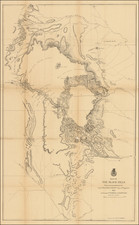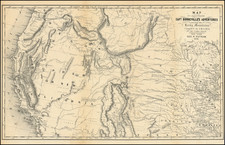Annotated by Marguerite Lindsley -- First Female Permanent National Park Ranger
Finely annotated map of Yellowstone, signed on the verso by Marguerite L. Arnold, America's first full time park ranger.
Originally issued by the US Geological Survey in 1883-85, the map was revised by E.P. Davis in 1910 and by C.H. Birdseye in 1921.
The map notes an meticulously tracks seven routes of the following important explorers:
- John Colter (1807) (Blue)
- Old Bannock Trail (historic Native American Trail) (Orange)
- Walter W. De Lacy (1863 Snake River Expedition) (Dark Brown)
- Cook Folsom (Cook–Folsom–Peterson Expedition of 1869) (Green)
- Washburn Doane (Washburn–Langford–Doane Expedition 1870) (Red)
- Hayden Expedition (1871) (Purple)
- General Howard's Wagon Road (1877-78) (Burnt Orange)
Curiously, there appear to be several additional unnamed routes for which there is not an obvious explanation, inluding
- Black
- Dashed Black
- Dashed Blue
- Hatched Purple
- Dashed Brown
We suspect the dashed blue line is the Colter route and is represented as dashed because of a lack of certainty of the route taken by Coulter. The remaining routes shown may be secondary routes taken by members of parties listed in the 6 other named routes or other "tentative" information.
Given that Lindsley has used her married, name, we suspect that this map was in her possession after her marriage in 1928 and was likely something she was using as part of her research and/or educational presentations to visitors.
Jane Marguerite LIndsley
Jane Marguerite LIndsley (later Lindsley Arnold) (1901-1952) was the first woman to hold the position of full time park ranger in the United States National Park Service.
Lindsley was born and raised in Yellowstone, daughter of Chester Lindsley, Yellowstone's superintendent during its tranistion from Army control to National Park Service. Growing up in Yellowstone gave her strong unique bond to the park.
Lindsley attended Montana State College, thenearned a master’s degree in bacteriology from the University of Pennsylvania. After working briefly in a lab, she bought a motorcycle and back to Yellowstone, where she would soon apply in 1925 for a position as a full time park ranger.
Some government officials, including Chief Inspector J.F. Gartland of the Department of the Interior, voiced strong opposition to hiring female rangers. Lindsley would later describe the pressure she felt, noting "many still think that women's work should be inside and it is a problem sometimes to satisfy everyone even tho [sic] I may be qualified for the work in the field."
Lindsley was a colleague of other early women in Yellowstone, including Irene Wisdom, Frieda Nelson, and Elizabeth Conard.
The following is excerpted from a National Park Service article on Lindsley:
In 1921, Marguerite Lindsley was one of three women to be appointed as season Park Rangers by Superintendent Horace Albright. In 1925, she became the first permanent female Park Ranger. . . Marguerite’s love for Yellowstone was no doubt born from her childhood [in Yellowstone]. Her father, Chester Lindsley worked as a civilian clerk for the Army when she was child, and the family lived in Mammoth. Her father also served as the interim Superintendent during the transition from the Army to the National Park Service.. . . . Lindsley served as a naturalist, teaching visitors and leading tours, as well as writing about and drawing the plants in the park. She helped run a government information center and a small museum in Mammoth as well.
. . . when Lindsley was hired in 1921 there was no Ranger uniform for women. Lindsley chose to design her own uniform. A journalist for the Christian Science Monitor described Lindsley and her uniform:
“Picture a tall, clear eyed, boyish-bobbed, slender young woman, trim in her well-fitting, olive-green uniform with its shining silver badge denoting that she is a member of the Department of Interior, National Park service, immaculate in her high-necked white blouse and black tie, ranger-like in her highly polished leather boots, it is no wonder that at first she was indistinguishable from the other 34 rangers.”
Lindsley’s uniform worked. Other female rangers would copy and adapt her uniform to fit their specific jobs and assignments.
Marguerite Lindsley’s position as park ranger earned her some interesting nicknames like, “Geyser Peg” and “Paint Pot Peg.” On a three-week horseback park tour, she was leading a group of visitors through a thermal area when she fell through the crust into boiling mud. Although she suffered burns on her leg up to her knee, she still took the opportunity to teach the visitors about the dangers of thermal features. While we’re unsure of the date of this trip, the fact that she was asked to help lead it suggests that she had already been appointed a permanent park ranger, placing the trip somewhere between 1925 and 1928.
In 1928, Marguerite Lindsley married another Ranger and returned to seasonal Ranger employment. Although she no longer worked as a Ranger during the winter, she and her husband lived in the park all year round and she routinely joined her husband on ski patrols and back country trips.
A remarkable artifact of the activities of America's first female permanent National Park Ranger.













![[ Wyoming Attached To Dakota Territory ] The United States of America](https://storage.googleapis.com/raremaps/img/small/99363.jpg)
![[ Jackson Hole and Environs ] Geological Map of Portions of Wyoming, Idaho and Utah](https://storage.googleapis.com/raremaps/img/small/97191.jpg)
![Johnson's Washington Oregon and Idaho [Massive Dakota Territory]](https://storage.googleapis.com/raremaps/img/small/98348.jpg)
